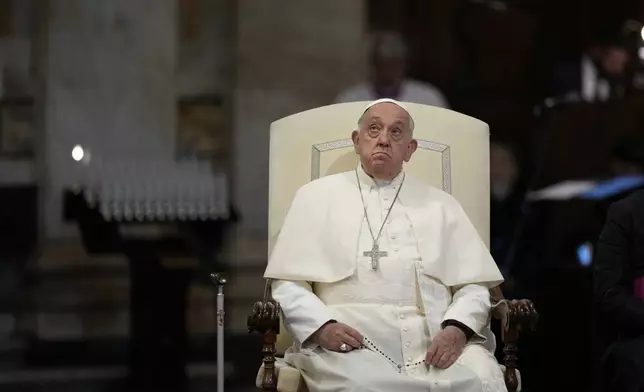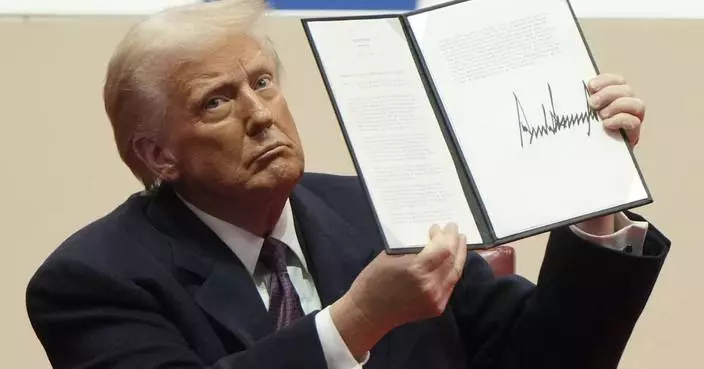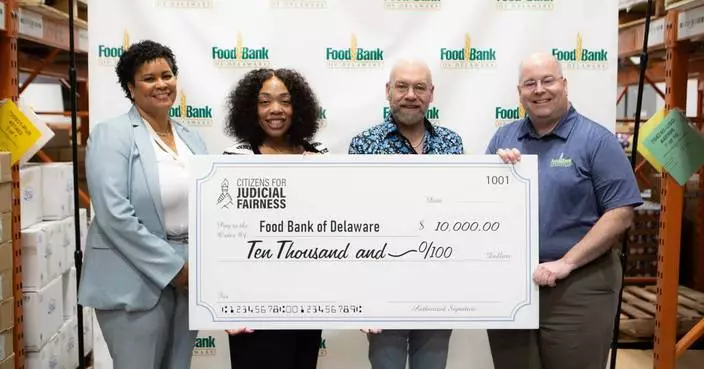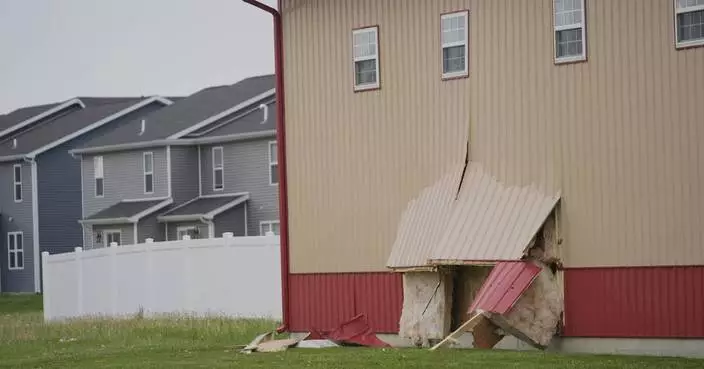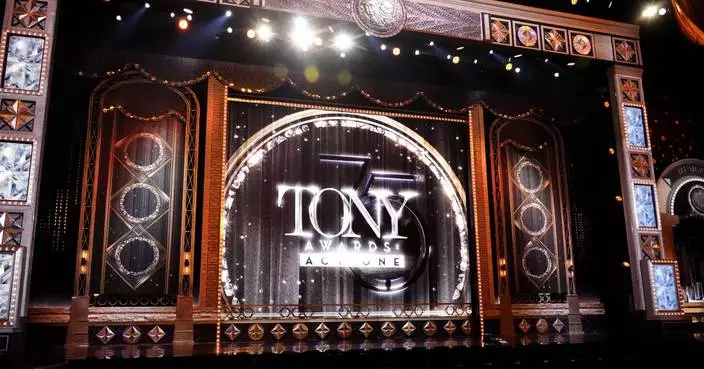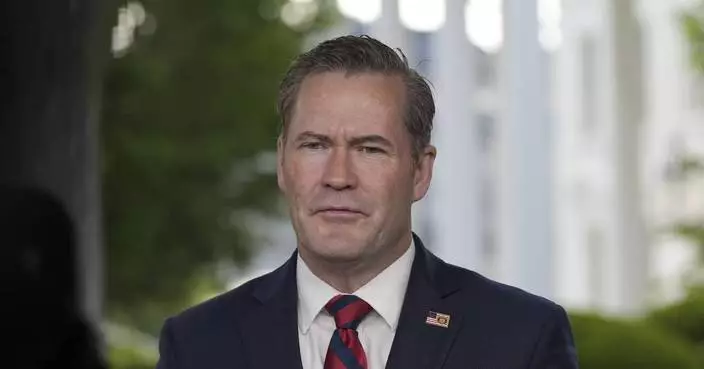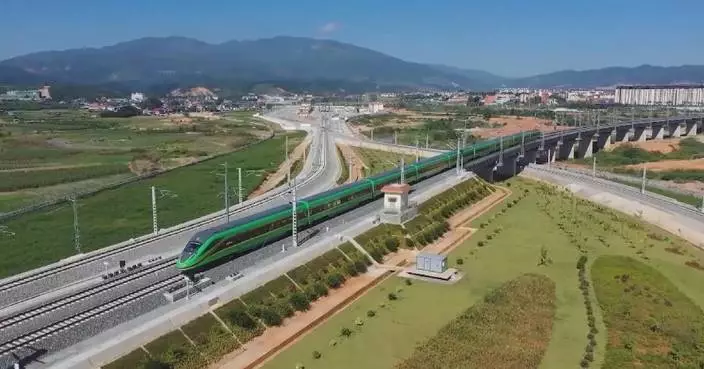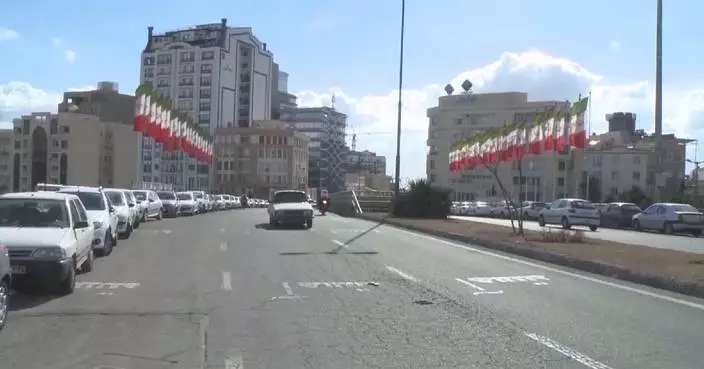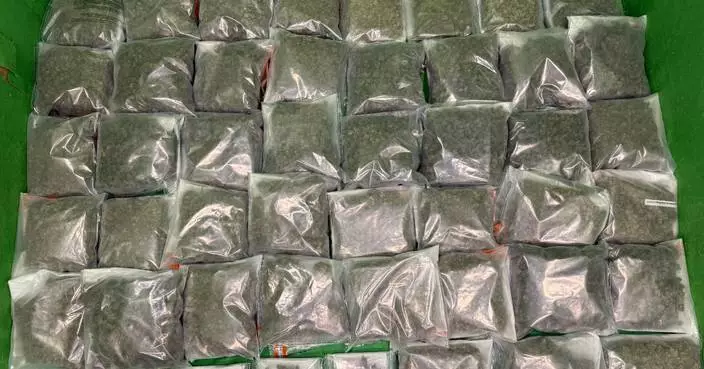A change in popes — through death or resignation — is a complicated process, with centuries-old rituals involving the transition in leadership for both the spiritual head of the global Catholic Church and the Vatican’s head of state.
These are the need-to-know terms — some of them in Latin — to help make sense of news in the coming days:
Click to Gallery
FILE - White smoke is seen billowing out from the chimney of the Sistine Chapel and announcing that a new pope has been elected on Wednesday, March 13, 2013. (AP Photo/Gregorio Borgia, File)
FILE - Black smoke emerges from the chimney on the Sistine Chapel as cardinals voted on the second day of the conclave to elect a pope in St. Peter's Square at the Vatican, Wednesday, March 13, 2013. (AP Photo/Michael Sohn, File)
FILE - Cardinal Tarcisio Isao Kikuchi, Archbishop of Tokyo, left, is congratulated by fellow cardinals after being elevated by Pope Francis during a solemn Mass in St. Peter's Basilica at the Vatican, Dec. 7, 2024. (AP Photo/Gregorio Borgia, File)
FILE - U.S. Cardinal Kevin Joseph Farrell presides over a vigil service over the death of George Floyd, a Black man who died after being restrained by Minneapolis police officers, in Rome's Santa Maria in Trastevere Church, June 5, 2020. (AP Photo/Andrew Medichini)
FILE - Pope Francis attends a prayer for peace at Rome's St. Mary Major Basilica, Sunday, Oct. 6, 2024. (AP Photo/Andrew Medichini, file)
This is the “chamberlain” — the cardinal in charge of formally verifying the pope’s death — and then sealing his room and study. Between then and the election of the new pope, the camerlengo administers the “goods and temporal rights” of the Holy See. The current one is the Irish-born American Cardinal Kevin Farrell.
There are 252 cardinals worldwide, and as a body, they are in charge of the Holy See’s affairs in-between popes, albeit with limits. Of them, 135 are “cardinal electors,” who gather in the Vatican to choose the new pope. For centuries, they have chosen one of their own. The vast majority of the electors — 108 — were made cardinals by Pope Francis, according to Vatican statistics.
This is the closed-door meeting of the cardinal electors to choose the new pope in the Sistine Chapel. Its name, literally "with a key,” was used in the 13th century to describe the process of locking up the cardinals until the election is completed. It must begin no more than 20 days after the death or resignation of a pope. The electors are sequestered from all outsiders for the duration; the last three popes were chosen within days.
The current dean is Italian Cardinal Giovanni Battista Re. He is the head of the College of Cardinals who informs the rest of the cardinals and the ambassadors to the Holy See of the pope’s death once he learns of it from the camerlengo. He convenes the conclave and presides as the electors take their oaths. Once a new pope is chosen, the dean asks him if he accepts and what name he wants to be called.
The 16th century church, built over the traditional tomb of the apostle St. Peter, is one of the largest Catholic basilicas in the world and is the centerpiece of Vatican City, headquarters of the 1.4 billion-strong Catholic Church. Starting Wednesday, the faithful will be invited to the church to pay their final respects to Francis, whose body will lay in state on the main altar. The Renaissance masterpiece was built and decorated by some of the most illustrious architects and artists of the time. Its grottoes contain the remains of popes past and its vast, marbled interior is home to some of the Vatican’s greatest treasures, including Michelangelo’s Pieta sculpture and Gian Lorenzo Bernini’s bronze baldacchino canopy over the main altar.
This Vatican guesthouse, built in 1996, specifically houses cardinals during a conclave and is used at other times as a hotel for visiting priests and Vatican officials. Pope Francis never moved out after he was elected pope, choosing to live in suite 201, rather than the papal apartments in the Apostolic Palace.
A Latin phrase for “all out,” it's spoken by the master for papal liturgical celebrations, currently Italian Archbishop Diego Ravelli, to ask all those present except the cardinal electors to leave the Sistine Chapel to begin the voting process during the conclave.
Each pope gets this ring at the Mass marking the beginning of his pontificate. It bears this name because Jesus told St. Peter, the first pope, that he would be “a fisher of men.” Until the 1990s, it was destroyed upon a pope’s death. Now, it’s “annulled,” or marked in such a way that it can’t be used as a seal.
This is the name given to the gathering of all members of the College of Cardinals after the pope’s death and before the start of the conclave to discuss major church affairs. All cardinals who aren't infirm take part in this meeting in the Vatican’s Apostolic Palace. They also discuss preparations for the conclave, under oath and in secret.
This Latin phrase translates to “We have a pope.” These are the words used by the “protodeacon” of the College of Cardinals to announce from the loggia of St. Peter’s Basilica that a new pope has been elected. He then says the new pope's birth name and the name he has chosen to use as pope, also in Latin. The current protodeacon is French Cardinal Dominique Mamberti.
These are the three cardinals, chosen by a random drawing from the electors, who are charged with gathering the ballots of any electors who are ill during the conclave.
This is Latin for “having had mercy and choosing him” — a phrase that Francis chose as his motto when he was elevated to bishop and kept as his papal seal. It was drawn from the homilies of St. Bede the Venerable, an 8th century monk. It comes from the Gospel narrative of St. Matthew, a tax collector whom Jesus called to follow him.
These are the three cardinals, chosen by random drawing from the electors, who are charged with reviewing the ballots during the conclave.
This is the document, or “deed,” listing key details of the pope’s life and papacy that is placed in his coffin. It’s written in Latin by the master for papal liturgical celebrations. A copy is kept in the Vatican archives.
These are the three cardinals, chosen by random drawing from the electors, who are charged with reviewing each ballot and announcing it to the assembled conclave after each round of voting. They then tally the votes — to win the election, two-thirds of the votes are necessary — and they also burn the ballots.
This is Latin for “vacant seat,” the period between the pope’s death or resignation and the election of a new one.
This is the basilica in Rome where Pope Francis said he wants to be buried. Francis is breaking with the tradition of his predecessors who are buried inside the Vatican, saying he wanted to be near his favorite icon of the Virgin Mary, the Salus Populi Romani, a Byzantine-style painting of the Madonna draped in a blue robe, holding the infant Jesus who in turn is holding a jeweled golden book. The icon is located in the church first built in the 5th century and devoted to the Virgin Mary. In his will, Francis said he wanted a simple underground tomb with only “Franciscus” written on it.
This Latin phrase means “the Lord’s whole flock.” It’s the Vatican constitution that regulates the processes from a pope’s death until a new one is elected. St. John Paul II issued it in 1996 during his papacy, and Pope Benedict XVI twice amended it, most significantly by removing John Paul's provision that after about 12 days of balloting a simple majority could elect a new pope rather than a two-thirds majority. If the conclave lasts that long, the top two vote-getters go to a runoff, with a two-thirds majority required to win. Neither of the top two candidates casts a ballot in the runoff.
After each round of voting in the Sistine Chapel, the ballots are burned in a special furnace to indicate the outcome to the outside world. If no pope is chosen, the ballots are mixed with cartridges containing potassium perchlorate, anthracene (a component of coal tar), and sulfur to produce black smoke. But if there is a winner, the burning ballots are mixed with potassium chlorate, lactose and chloroform resin to produce the white smoke. Bells also are rung to further signal there is a new pope.
Associated Press religion coverage receives support through the AP’s collaboration with The Conversation US, with funding from Lilly Endowment Inc. The AP is solely responsible for this content.

FILE - White smoke is seen billowing out from the chimney of the Sistine Chapel and announcing that a new pope has been elected on Wednesday, March 13, 2013. (AP Photo/Gregorio Borgia, File)

FILE - Black smoke emerges from the chimney on the Sistine Chapel as cardinals voted on the second day of the conclave to elect a pope in St. Peter's Square at the Vatican, Wednesday, March 13, 2013. (AP Photo/Michael Sohn, File)
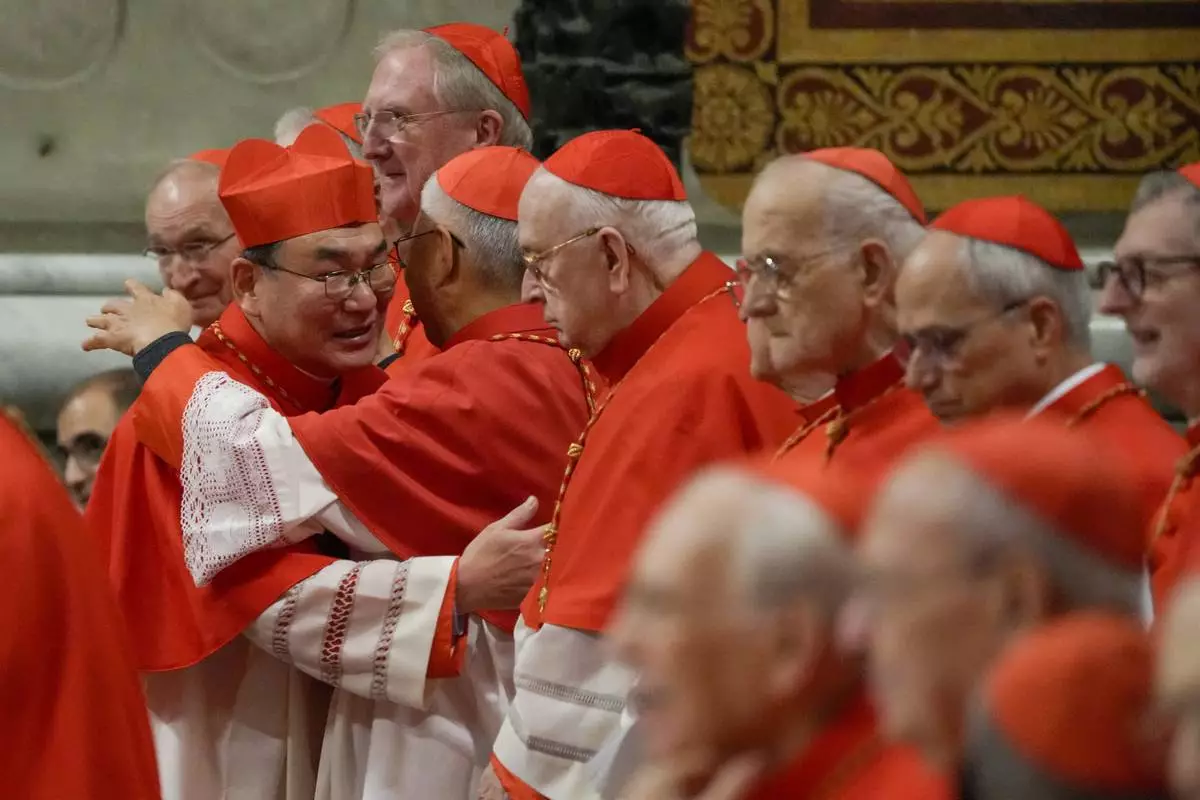
FILE - Cardinal Tarcisio Isao Kikuchi, Archbishop of Tokyo, left, is congratulated by fellow cardinals after being elevated by Pope Francis during a solemn Mass in St. Peter's Basilica at the Vatican, Dec. 7, 2024. (AP Photo/Gregorio Borgia, File)
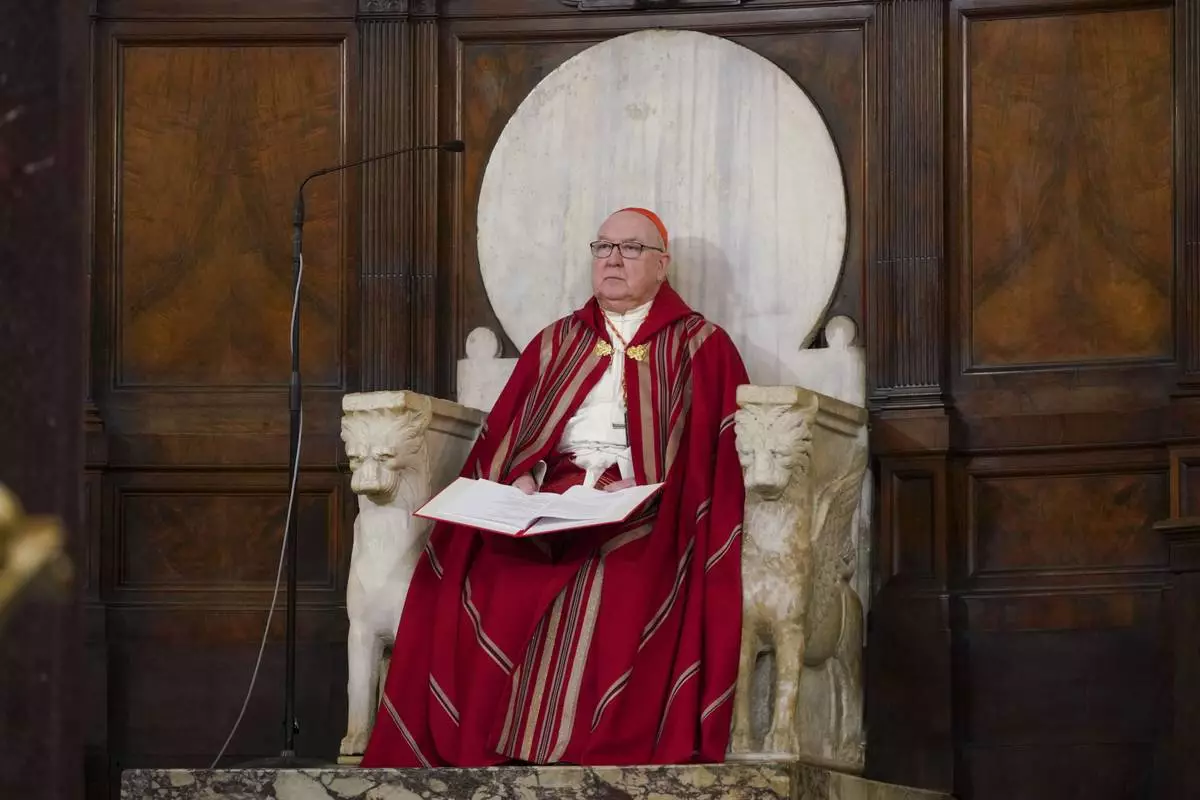
FILE - U.S. Cardinal Kevin Joseph Farrell presides over a vigil service over the death of George Floyd, a Black man who died after being restrained by Minneapolis police officers, in Rome's Santa Maria in Trastevere Church, June 5, 2020. (AP Photo/Andrew Medichini)

FILE - Pope Francis attends a prayer for peace at Rome's St. Mary Major Basilica, Sunday, Oct. 6, 2024. (AP Photo/Andrew Medichini, file)
WASHINGTON (AP) — To understand the Justice Department's struggles in representing President Donald Trump's positions in court, look no further than a quick succession of losses last week that dealt a setback to the administration's agenda.
In orders spanning different courthouses, judges blocked a White House plan to add a proof-of-citizenship requirement to the federal voter registration form, ruled the Republican administration violated a settlement agreement by deporting a man to El Salvador and halted directives that threatened to cut federal funding for public schools with diversity, equity and inclusion programs.
That's on top of arguments in which two judges expressed misgivings to a Justice Department lawyer about the legality of Trump executive orders targeting major law firms and a department lawyer's accidental filing of an internal memo in court questioning the Trump administration’s legal strategy to kill Manhattan’s congestion toll — a blunder the Transportation Department called “legal malpractice.”
According to an Associated Press tally, Trump executive actions have been partially or fully blocked by the courts around 70 times while judges have not impeded the president's orders in nearly 50 cases. Dozens of others are pending.
The Trump administration's effort to reshape American civil society, including a crackdown on illegal immigration and downsizing of the federal government, is encountering resistance from judges across a broad spectrum of philosophical leanings as lawyers for the Justice Department in some cases have strained to answer straightforward questions from judges about the basis or rationale for a particular policy or about the mechanics of its implementation. In at least one instance, a government lawyer who became openly exasperated in court at the lack of information he’d been given from the administration was soon after fired by the Justice Department.
Compounding the problem is an ongoing exodus from the department of experienced career lawyers accustomed to representing the federal government in court. Some of the key arguments in recent weeks have been handled by lawyers newly hired into political, rather than career, positions at the department.
Justice Department leadership has in recent months hired lawyers with conservative credentials from law firms in Washington and with past experience at state and local government agencies — but not necessarily federal experience.
“This is quite rare, if not unprecedented,” said Boston College law professor Kent Greenfield. “I can't think of another instance in which the Justice Department has lost so many cases in a short period of time and the reason they're losing is because they're wrong — and obviously wrong.”
Trump administration officials, including Attorney General Pam Bondi, have attributed the losses to what they call “activist” judges bent on impeding his agenda. Some White House allies have called for impeaching judges, with adviser Elon Musk describing it as a “judicial coup.”
But that belies the reality that some of the most blistering rebukes of Justice Department arguments have come from conservative judges like J. Harvie Wilkinson III, an appointee of Republican President Ronald Reagan who said in an April opinion that the idea the government could not return to the U.S. a man it had deported to El Salvador was “shocking not only to judges, but to the intuitive sense of liberty that Americans far removed from courthouses still hold dear."
Jonathan Turley, a George Washington University law professor, cautioned against making too much so soon in the administration of its legal track record. The Supreme Court with its conservative 6-3 majority, including three Trump appointees, has yet to weigh in on the vast majority of the cases.
“This Department of Justice will continue to defend President Trump’s agenda in court, and we remain confident that we will ultimately prevail,” Justice Department spokesperson Chad Gilmartin said in an email.
The Trump administration has also succeeded in some cases in beating back legal challenges, and some early defeats at the trial court level have been subsequently overturned by a federal appeals court, such as when a panel cleared the way for the administration to fire thousands of probationary workers in spite of a judge’s earlier opinion.
In another case, the Supreme Court overturned a lower judge's order that had blocked the administration from using an 18th-century wartime law to deport Venezuelan migrants, though the court said they must get a chance to challenge their removals before they're taken from the United States. The Supreme Court also recently granted the Trump administration’s plea to cut hundreds of millions of dollars in teacher training money while a lawsuit continues.
“There’s over 600 District Court judges, any one of which can issue limited or national injunctions,” Turley said. The rulings may be important, he added, “but there’s a great deal of runway between a U.S. district court and the United States Supreme Court.
The challenges, however, were laid bare in a Washington courtroom just last week when Richard Lawson, a newly minted deputy associate attorney general, repeatedly struggled to provide what a judge said was “basic” information about one in a series of executive orders targeting a major law firm with punishing sanctions — including the suspension of attorney security clearances.
“So you don’t know whether the firm or the individuals whose security clearances were suspended have been given any notice about the timing of the review, who the decision-maker is, the information that’s being reviewed as part of this review, whether they’re going to have an ability to see that information, comment on the information, correct the information, object to the information?” U.S. District Judge Beryl Howell asked pointedly. “You can’t tell me anything about that?”
“I can't speak to that, Your Honor," replied Lawson, who years before recently joining the Justice Department had worked with Bondi in the Florida attorney general's office and was also a lawyer at a pro-Trump think tank called the America First Policy Institute.
Lawson fared no better weeks earlier when pushed to explain the administration's national security rationale for punishing a different law firm, Jenner & Block, because one of its former partners, Andrew Weissmann, had years earlier been a prosecutor on the team of special counsel Robert Mueller that investigated Trump during his first term.
“You’re not going to really tell me that having someone employed four years ago poses some kind of national security threat?” asked U.S. District John Bates, an appointee of George W. Bush, a Republican.
“Not per se, no,” replied Lawson.
In another case, Judge Colleen Kollar-Kotelly scolded the Justice Department in court papers last week over what she described as the “contradiction” between statements made in court by one of its lawyers “and the facts on the ground.” While the judge did not contend that the lawyer "intentionally misrepresented the facts," the appointee of Democratic President Bill Clinton added: “The Court must remark that this exchange does not reflect the level of diligence the Court expects from any litigant — let alone the United States Department of Justice."
Stuart Gerson, who led the Justice Department’s civil division under Republican President George H.W. Bush and later served briefly as acting attorney general, said it appeared the Trump administration was sending lawyers into court "without adequate information and instructions.”
“I sympathize greatly with these folks who are arguing some of the cases, who are just parroting what they’ve been told to say without being able to answer questions about their ramifications, the what-ifs and the background information,” Gerson said.
Follow the AP's coverage of the U.S. Department of Justice at https://apnews.com/hub/us-department-of-justice.
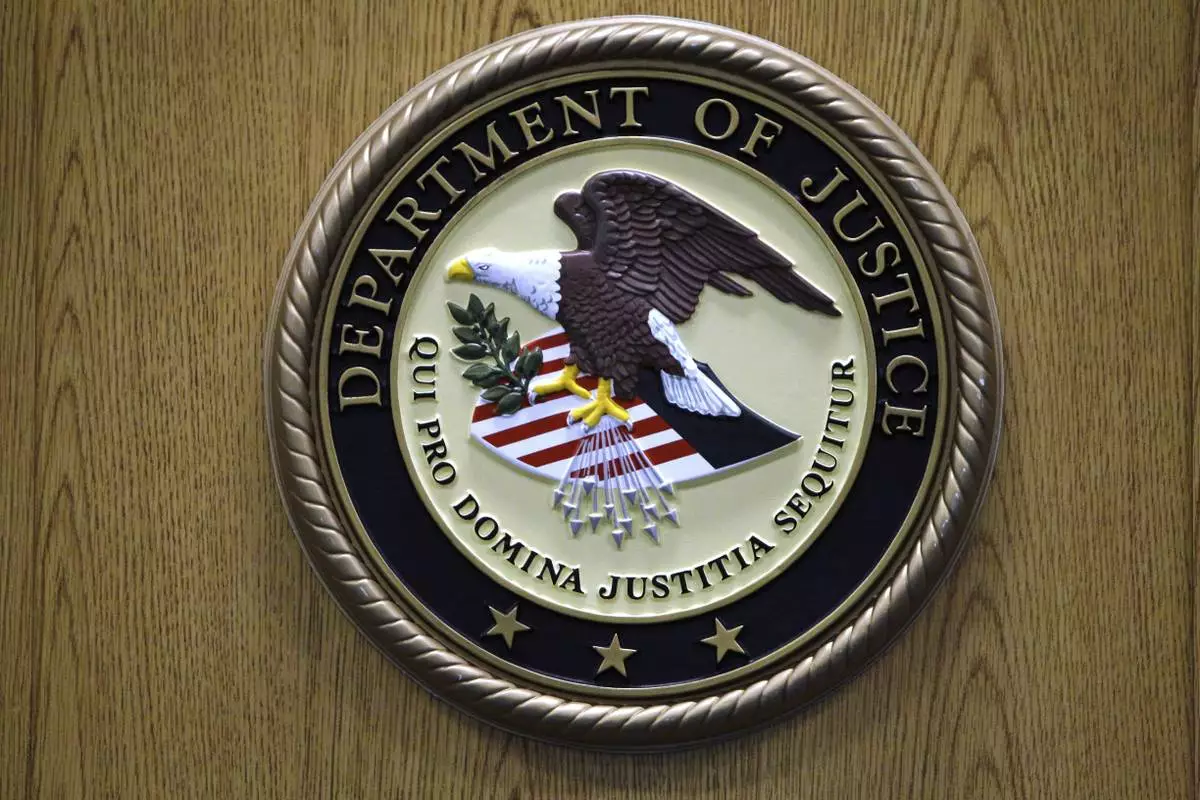
FILE - The Department of Justice logo is shown on a podium during a news conference, Sept. 30, 2010, in Philadelphia. (AP Photo/Matt Slocum, File)












